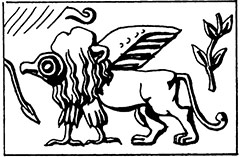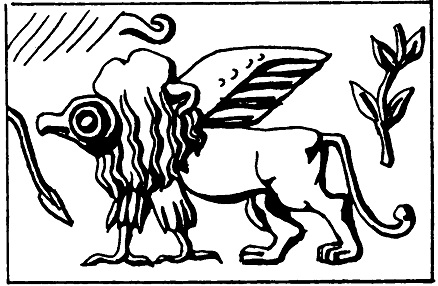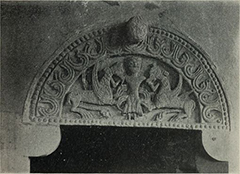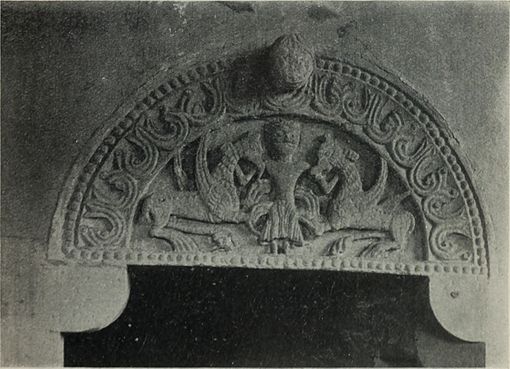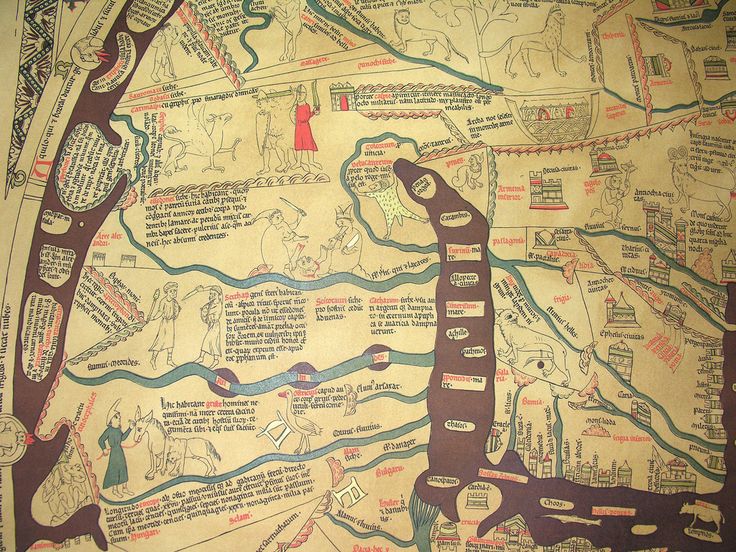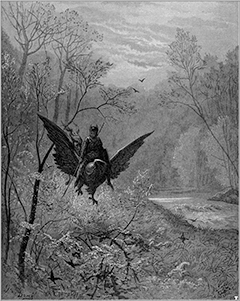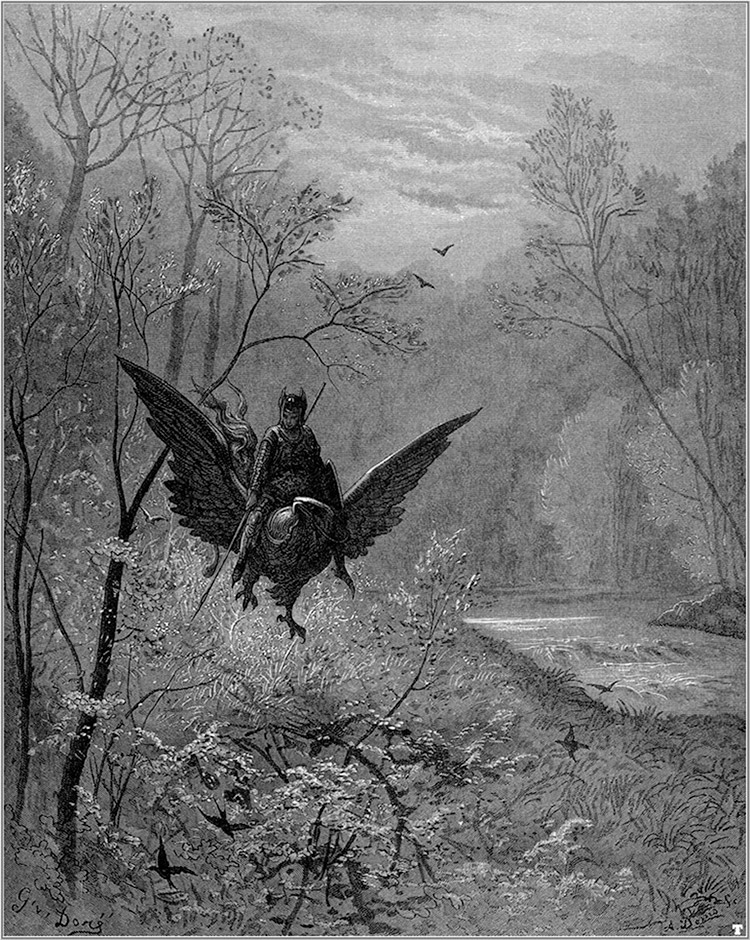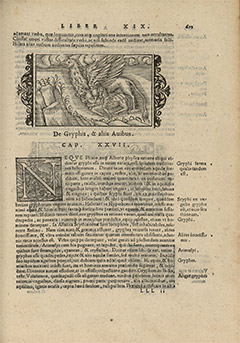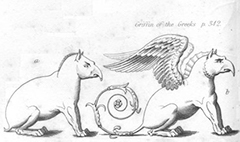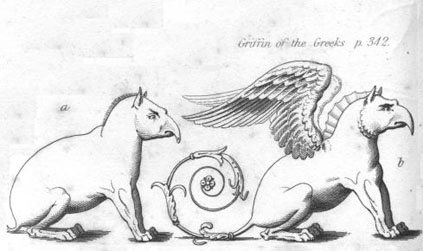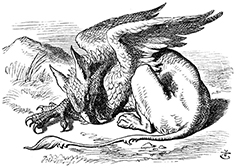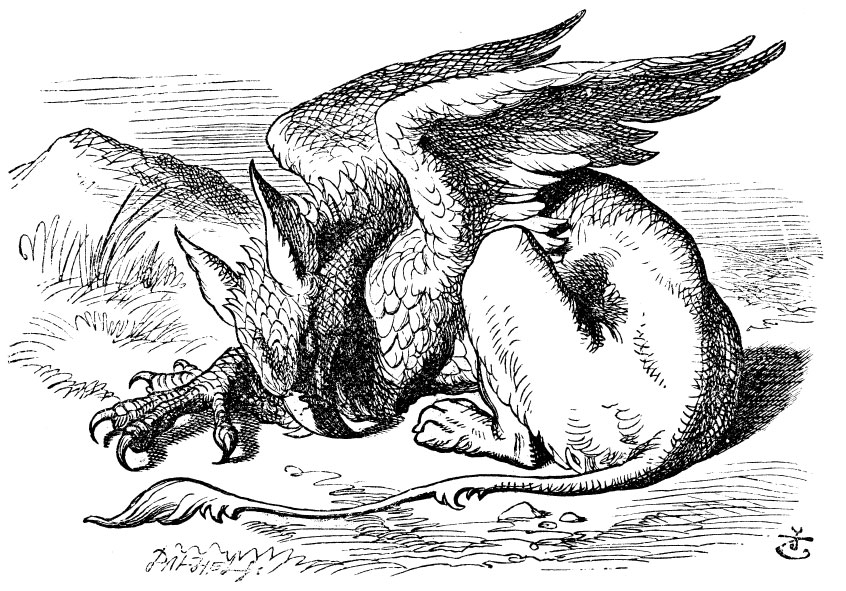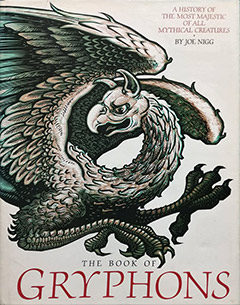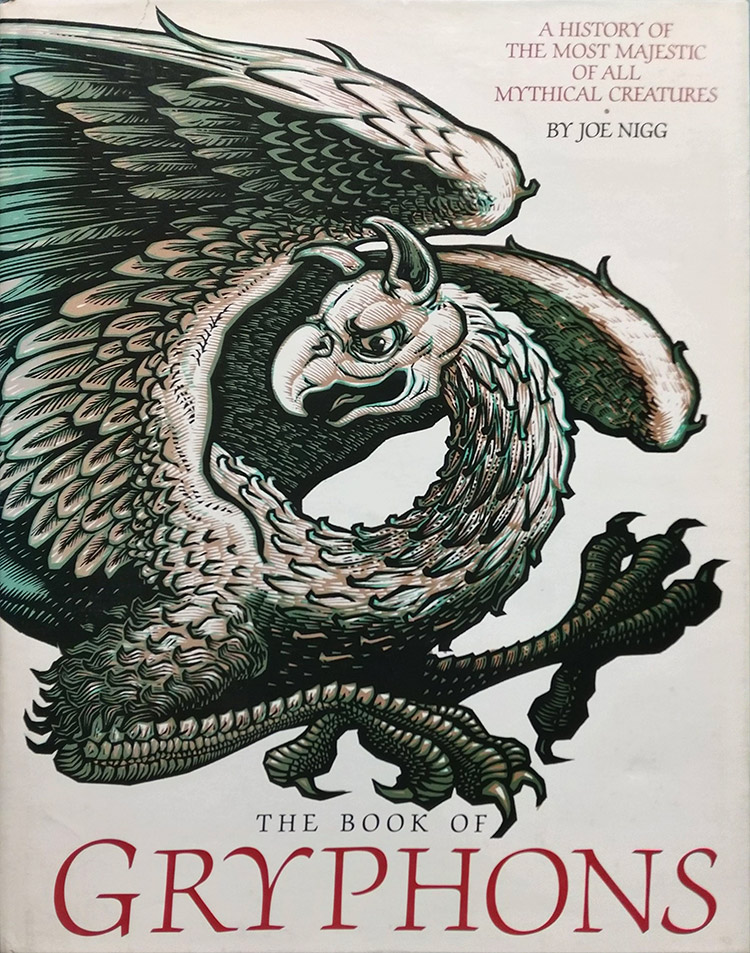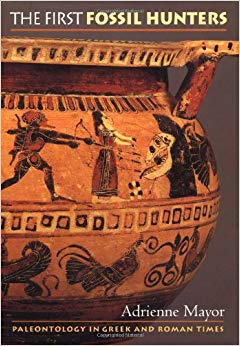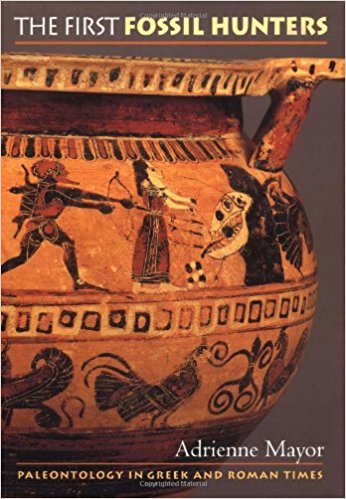Gryphons Through History: A Timeline
Enjoy a flight through history as you explore the visual and written milestones of the most majestic of all mythical creatures, the gryphon.
Spanning from the mountains of Mongolia to the deserts of Egypt, there is far more to the myth of the gryphon than is commonly known. This timeline will take you through 5,000 years of gryphon history, from the discovery of the first gryphon iconography on a seal in Iran to modern literature attempting to unravel the gryphon myth.
3000 BCE
- 3000 BCE: FIRST GRYPHON IMAGE
-
Visual art
First gryphon image found on a seal in Susa, the capital of ancient Elam (now Iran).
700 BCE
- 0675 BCE: ARISTEAS WRITES ABOUT GRYPHONS AND ARIMASPIANS
-
Factual Writing
The vast majority of what we know about Aristeas comes from Greek historian Herodotus. Aristeas is the first person that we know of who has written about Gryphons, immortalizing them in his poem, "Arimaspia", one of the first tales from a Greek of far eastern lands. Arimaspians are also the race of one-eyed giant men whom Aristeas says fought the gryphons for gold in the mountains. Not only was Aristeas the first person to document Gryphons, but he was also the first to write of the Issedones (the furthest North he traveled), and the Arimaspians, the one-eyed adversaries of Gryphons. A subject of note is that Aristeas was supposedly dead when he wrote his poem. Let me explain. Herodotus writes in his Histories, that while in a shop in Proconessus, Aristeas had suddenly dropped stone dead, disappeared for six years, returned to Proconessus and wrote his poem, then disappeared again. (He turned up 250 years later to demand that a statue be built of him.) Unfortunately, much like its creator, Arimaspia has been lost to Time and is no longer extant.
500 BCE
- 0440 BCE: FIRST EXTANT WRITTEN APPEARANCE OF GRYPHONS - "THE HISTORIES" BY HERODOTUS
-
Factual Writing
"The Father of History", so called by Cicero, traveled through much of the ancient world and meticulously recorded all that he saw and heard into nine volumes of one of the first prose histories of the Western world, simply called, The History. It is from his work that most of our knowledge of Aristeas of Proconessus is derived, and it also contains one of the earliest accounts of Gryphons that remains today. Although Herodotus records what he has heard about gryphons, he gives no physical description and only speaks of their gold-hoarding nature from the one-eyed Arimaspians. The parts about gryphons are in Book 3, Chapter 116, Section 1; Book 4, Chapter 13, Section 1; and Book 4, Chapter 27, Section 1.
Book 3, Chapter 116, Section 1:
"But in the north of Europe there is by far the most gold. In this matter again I cannot say with assurance how the gold is produced, but it is said that one-eyed men called Arimaspians steal it from griffins."
Book 4, Chapter 13, Section 1:
"There is also a story related in a poem by Aristeas son of Caüstrobius, a man of Proconnesus. This Aristeas, possessed by Phoebus, visited the Issedones; beyond these (he said) live the one-eyed Arimaspians, beyond whom are the griffins that guard gold, and beyond these again the Hyperboreans, whose territory reaches to the sea."
Book 4, Chapter 27, Section 1:
"Of these too, then, we have knowledge; but as for what is north of them, it is from the Issedones that the tale comes of the one-eyed men and the griffins that guard gold; this is told by the Scythians, who have heard it from them; and we have taken it as true from the Scythians, and call these people by the Scythian name, Arimaspians; for in the Scythian tongue “arima” is one, and “spou” is the eye."
- 0430 BCE: THE HOUNDS OF ZEUS - "PROMETHEUS BOUND" BY AESCHYLOS
-
Fictional Writing
This Ancient Greek tragedy regards the myth of Prometheus. In the play (lines 803-806), Prometheus warns Io of many dangers he may encounter on his journey, including gryphons.
"Beware of the sharp-beaked hounds of Zeus that do not bark, the gryphons, and the one-eyed Arimaspian folk, mounted on horses, who dwell about the flood of Pluto's stream that flows with gold."
400 BCE
- 0400 BCE: FIRST DESCRIPTION OF GRYPHONS - "INDIKA" BY CTESIAS
-
Factual Writing
Ctesias (Ktesias) the Cnidian was a physician at the royal Persian court for seventeen years, during which period he wrote two books, Persica, a history of Persia, and Indika, a collection of tales of the distant land which he most likely heard of while at court. He does his best to defend himself though, as he writes: "Ktesias thus writing and romancing professes that his narrative is all perfect truth, and, to assure us of this, asservates that he has recorded nothing but what he either saw with his own eyes, or learned from the testimony of credible eye-witnesses." It is in his second book, Indika, which we find a menagerie of fabulous beasts, such as the martikhora (manticore), the wild ass of India (unicorn), and Gryphons. Ctesias provides us with a very fine (and colorful) description of the beasts, but note that Aristeas placed the Gryphons beyond the Issedones, which is far north of India.
"Gold is not obtained in India from the sands of rivers by washing, as it is from the Pactolus, but is found in lofty mountains inhabited by griffins. These are birds with four legs, of the size of a wolf, with the legs and claws of a lion, having red feathers on the breast, but black on the rest of the body. It is difficult to procure the gold on account of these birds."
100 BCE
- 0037 BCE: FIRST IDEA ABOUT A HIPPOGRIFF - "ECOLOGUES" BY VIRGIL
-
Fictional Writing
The "Eclogues" are a series of 10 poems by the famous Roman poet, Virgil. In Eclogue 8, Virgil uses imagery of a gryphon mating with a horse to indicate impossible love.
"Nysa to Mopsus given! what may not then
We lovers look for? soon shall we see mate
Griffins with mares, and in the coming age
Shy deer and hounds together come to drink."
0 CE
- 0044 CE: BEYOND THE MOUNTAIN RIPHEY - "DE SITU ORBIS" BY POMPONIUS MELA
-
Factual Writing
"De Situ Orbis" ("The Situation of the World") is a general geographical work of the known world written by the first Latin geographer, Pomponius Mela. The work is comprised into three different books, with the far off places of Scythia, India, Arabia and Ethiopia comprising mostly the last book. Mela moves the Gryphons again, this time west of the Issedones to the mountain Riphey, in Scythia. Like Herodotus though, he provides no descriptions of the creatures, yet remarks on their animal nature. Translation from Joe Nigg's Book of Fabulous Beasts.
"The boundaries and location of Asia, extending to our Sea and the river Tanais, are such as I have shown before. Now to them that row back again down the same river into Maeotis, on the right hand is Europe, which was directly on the left side of them as they sailed up the stream. The river borders the mountain Riphey. The snow which falls continually makes the country inaccessible to travel. Beyond is a country of very rich soil, but it is uninhabitable because the Griffons (a cruel and unyielding kind of wild beast) jealously love the gold which lies above the ground and are very hostile to anyone who approaches it. The first men are Scythians, and of the Scythians, the first are the Arimaspians: which are reported to have but one eye apiece. From there up to Maeotis are the Issedones..."
- 0070 CE: WILD GOLD GUARDING BEASTS - "NATURALIS HISTORIA" BY PLINY THE ELDER
-
Factual Writing
One of the most influential and monumental works of the ancient age, the Naturalis Historia was compiled by Pliny the Elder from over 2000 tomes and hundreds of authorities, and is the only book of the many which Pliny had written which has withstood the test of Time. It was considered "the" standard work of natural science until it was discredited sometime in the seventeenth century. It is interesting to note that Pliny writes more of the Arimaspians and their flesh-eating monstrous nature than of the Gryphons, which again receive very little description. He also casts doubt upon the credulity of what he is reporting, but he seems determined to tell the world what he knows.
Book 7, Chapter 2:
"We have already stated, that there are certain tribes of the Scythians, and, indeed, many other nations, which feed upon human flesh. This fact itself might, perhaps, appear incredible, did we not recollect, that in the very centre of the earth, in Italy and Sicily, nations formerly existed with these monstrous propensities, the Cyclopes, and the Læstrygones, for example; and that, very recently, on the other side of the Alps, it was the custom to offer human sacrifices, after the manner of those nations; and the difference is but small between sacrificing human beings and eating them.
In the vicinity also of those who dwell in the northern re- gions, and not far from the spot from which the north wind arises, and the place which is called its cave, and is known by the name of Geskleithron, the Arimaspi are said to exist, whom I have previously mentioned, a nation remarkable for having but one eye, and that placed in the middle of the forehead. This race is said to carry on a perpetual warfare with the Griffins, a kind of monster, with wings, as they are commonly represented, for the gold which they dig out of the mines, and which these wild beasts retain and keep watch over with a singular degree of cupidity, while the Arimaspi are equally desirous to get possession of it. Many authors have stated to this effect, among the most illustrious of whom are Herodotus and Aristeas of Proconnesus.Book 10, Chapter 70:
"I look upon the birds as fabulous which are called "pegasi," and are said to have a horse's head; as also the griffons, with long ears and a hooked beak. The former are said to be natives of Scythia, the latter of Æthiopia. The same is my opinion, also, as to the tragopan; many writers, however, assert that it is larger than the eagle, has curved horns on the temples, and a plumage of iron colour, with the exception of the head, which is purple. Nor yet do the sirens obtain any greater credit with me, although Dinon, the father of Clearchus, a celebrated writer, asserts that they exist in India, and that they charm men by their song, and, having first lulled them to sleep, tear them to pieces. The person, however, who may think fit to believe in these tales, may probably not refuse to believe also that dragons licked the ears of Melampodes, and bestowed upon him the power of understanding the language of birds; as also what Democritus says, when he gives the names of certain birds, by the mixture of whose blood a serpent is produced, the person who eats of which will be able to understand the language of birds; as well as the statements which the same writer makes relative to one bird in particular, known as the "galerita,"—indeed, the science of augury is already too much involved in embarrassing questions, without these fanciful reveries."
100 CE
- 0150 CE: REPEATING ARISTEAS - "DESCRIPTION OF GREECE" BY PAUSANIAS
-
Factual Writing
"Description of Greece", a collection of Pausanias's "first hand accounts" of the entire country, provides a remarkable look at that ancient world, and is still used today as a relative guidebook by archaeologists and historians. In the work, Pausanias notices Gryphons on the helmet of a statue of Athena and then refers to Aristeas's Arimaspia, much like Herodotus before him. At least here he also provides a general description of them. Later on in the book he again writes of gryphons, dispersing a rumor about them (after previously claiming that he would write no more about them). Of interesting note, the second paragraph (about gryphons having spots), is used to discredit an immediately preceding claim about werewolves.
In the "Attica" book, Chapter 24, Section 6:
"These griffins, Aristeas of Proconnesus says in his poem, fight for the gold with the Arimaspi beyond the Issedones. The gold which the griffins guard, he says, comes out of the earth; the Arimaspi are men all born with one eye; griffins are beasts like lions, but with the beak and wings of an eagle. I will say no more about the griffins."
Book "Arcadia", Chapter 2, Section 7:
"Similarly too it is said that Niobe on Mount Sipylus sheds tears in the season of summer. I have also heard that the griffins have spots like the leopard, and that the Tritons speak with human voice, though others say that they blow through a shell that has been bored. Those who like to listen to the miraculous are themselves apt to add to the marvel, and so they ruin truth by mixing it with falsehood."
200 CE
- 0200 CE: GRYPHON FIERCENESS - "COLLECTANEA RERUM MEMORABILIUM" BY SOLINUS
-
Factual Writing
"The opus of Gaius Julias Solinus, "Collectanea Rerum Memorabilium", was one of the most frequently cited books for over a thousand years, yet is now considered nothing more than a poorly written and compiled collection of interesting tales. Solinus borrowed heavily from Pliny and Mela's works (earning him the name "Pliny's ape"), as well as other authors before him. Note that he places the homeland of the Gryphons in the mountain Riphey, just as Mela had done over one hundred years earlier. It is also interesting that he turns the Gryphon from a colorful animal protecting its young from outsiders (as Aelian wrote) into fierce beasts, "cruel beyond all cruelty", a symbol of punishment for those controlled by avarice. Translation from Joe Nigg's Book of Fabulous Beasts.
"The Arimaspes, which are situated about Gesglithron, are a people that have but one eye. Beyond them and the Mountain Riphey is a country continually covered with snow, called Pteropheron. For the incessant falling of the hoarfrost and snow makes it look like feathers. A damned part of the world is it, and drowned by nature itself in the cloud of endless darkness, and utterly shut up in extreme cold as in a prison, even under the very North Pole. Only of all lands it knows no distinction of times, neither receives it anything else of the air than everlasting winter. In the Asiatik Scythia are rich lands, but notwithstanding the uninhabitable.
For whereas they abound in gold and precious stones, the Gryffons possess all, a most fierce kind of fowl, cruel beyond all cruelty, whose outrageousness stops all comers, so that hardly and seldom arrive any there. For as soon as they see them they tear them in pieces, as creatures made of purpose to punish the rashness of covetous folk.
The Arimaspes fight with them to get away their precious stones..."
- 0220 CE: DESCRIPTION OF GRYPHONS - "DE NATURA ANIMALIUM" BY AELIAN
-
Factual Writing
"The De Natura Animalium is Claudius Aelianus's compilation of stories and tales from others before him, borrowing heavily from sources like Ctesias, Herodotus, Pliny, Aristotle (c. 384-322 BC) and others. His lengthy description of Gryphons is one of the most detailed and informative of all of the ancient writers, and essentially holds all of the common information known about the creatures: their description, their gold hoarding nature, their fight with other people for that gold. Note however that Aelian makes no mention of the Arimaspians. (Nor did Ctesias for that matter.) Translation from Joe Nigg's Book of Fabulous Beasts.
"I have heard that the Indian animal the Gryphon is a quadruped like a lion; that it has claws of enormous strength and that they resemble those of a lion. Men commonly report that it is winged and that the feathers along its back are black, and those on its front are red, while the actual wings are neither but are white. And Ctesias records that its neck is variegated with feathers of a dark blue; that it has a beak like an eagle's, and a head too, just as artists portray it in pictures and sculpture. Its eyes, he says, are like fire. It builds its lair among the mountains, and although it is not possible to capture the full-grown animal, they do take the young ones. And the people of Bactria, who are neighbors of the Indians, say that the Gryphons guard the gold in those parts; that they dig it up and build their nests with it, and that the Indians carry off any that falls from them. The Indians however deny that they guard the aforesaid gold, for the Gryphons have no need of it (and if that is what they say, then I at any rate think that they speak the truth), but that they themselves come to collect the gold, while the Gryphons fearing for their young ones fight with the invaders. They engage too with other beasts and overcome them without difficulty, but they will not face the lion or the elephant. Accordingly the natives, dreading the strength of these animals, do not set out in quest of the gold by day, but arrive by night, for at that season they are less likely to be detected. Now the region where the Gryphons live and where the gold is mined is a dreary wilderness. And the seekers after the aforesaid substance arrive, a thousand or two strong, armed and bringing spades and sack; and watching for a moonless night they begin to dig. Now if they contrive to elude the Gryphons they reap a double advantage, for they not only escape with their lives but they also take home their freight, and when those who have acquired a special skill in the smelting of gold have refined it, they possess immense wealth to requite them for the dangers described above. If however they are caught in the act, they are lost. And they return home, I am told, after an interval of three or four years."
- 0220 CE: WEIRD WINGS - "THE LIFE OF APOLLONIUS OF TYANA"
-
Factual Writing
Flavius Philostratus wrote that Empress Julia Doma, of whose literary circle he was a part of, (along with his friend, Aelian) presented him with the memoirs of a wandering prophet, Apollonius, and ordered him to write the life history of Apollonius in order to increase that prophet's decreasing credibility. The memoirs, in turn, were written by one of Apollonius' disciples, Damis. The result of Philostratos' work is The Life of Apollonius of Tyana, a rousing tale of marvel and mysticism. The way Philostratos writes of the Gryphons is remarkable in that he hits on the three major symbolic elements of the gryphon: gold, the Sun, and chariots. Note however the exceptional "wings" which he attributes to gryphons.
BOOK II - CHAP. XLVIII
"The gold said to be dug out of the earth by the griffons, [Herodotus speaks of the griffons, as guardians of the gold] is found in stones, which are sprinkled all over with drops of gold, that shine like so many sparks of fire, these stones they break in pieces with thear beaks. The griffons found in India are held sacred to the sun, who is always painted in a chariot drawn by four of them. These animals are as strong and large as lions, against whom they carry on successful war by the assistance of their wings; and it is added, they sometimes overcome the elephant and dragon in battle. They never rise to a great height in flying, being not able to surpass in velocity the most sluggish bird. They have not such feathers as other birds, but the pinions of their wings are fastened by a red membrane, which enables them to fly a little, wheel about, and fight off the ground. The tiger is the only animal not to be conquered by them, and the reason is, that his swiftness is equal to that of the winds."
BOOK VI - CHAP. I.
"In them [Ethiopia and Egypt] we find wild beasts and black men, that are to be found no where else. In both, we meet with pygmies and cynocephali, who possess different modes of barking, and other marvellous things besides. The griffons of India, and the ants of Ethiopia, though not exactly shaped alike, are possessed of the same instinct, according to the account given of them. In both countries, they are the guardians of the gold, and attached to the soil which produces it."
600 CE
- 0630 CE: BESTIARY PROTOTYPE - "ETYMOLOGIES" BY ISIDORE OF SEVILLE
-
Factual Writing
The prototype of traditional medieval bestiaries, St. Isidore's Etymologies was also a major reference and influence upon similar later works. A highlight of the Etymologies was that it presented creatures in a straightforward, almost scientific approach, as opposed to the usual Christian allegorical and emblematic method of the time. In the work, St. Isidore classifies the Gryphon under "beasts of prey". Translation from Barney, A., Lewis, W., Beach, J., & Berghof, O. (2006). The Etymologies of Isidore of Seville. Cambridge University Press, p. 252
"The griffin (grypes) is so called because it is an animal with feathers (perhaps cf. grus, “crane”) and four feet (pes). This kind of wild animal is born in the Hyperborean mountains. They are lions in their entire torso, but they are like eagles in their wings and faces. They are violently hostile to horses. They also tear humans apart when they see them."
900 CE
- 0900 CE: GRYPHON ATTACKS SAILORS - "THE VOYAGE OF ST. BRENDAN"
-
Fictional Writing
"The Voyage of St. Brendan" is an account of an Irish monk's 7 year sea voyage to discover the Promised Land of the Saints. Saint Brendan, who lived from 484 to 578, is said to have traveled about Ireland and the Scottish islands, and possibly Wales on his expedition. Many other Irish monks sailed on various quests, but St. Brendan was the most famous, and he quickly rose to legendary status. During his voyage, he and his crew were attacked by a lone Gryphon, although are saved by another large bird. (For another account of Gryphons attacking sailors, see Benjamin of Tudela.) Translation from O'Donoghue, D. (Ed.). (1893). Brendaniana: St. Brendan the Voyager in story and legend. Doublin: Browne & Nolan. pp. 155-156.
"After that period, they embarked again, taking with them some of the fruits of the island, and sailed along as the winds shaped their course, when suddenly there appeared flying towards them the bird called 'Gryphon'. When the brethren saw it, they cried out to the holy father: "Help us, O father, for this monster comes to devour us.' But the man of God told them to fear it not, for God was their helper. And then another great bird came into view, and in rapid flight flew against Gryphon, engaging it in a combat, that seemed some time of doubtful event; but at length, tearing its eyes, it vanquished and slew it; and the carcass into the see, in the sight of all the brethren, who they upon gave thanks and praises to God; while the bird which gained the victory flew away, whence it had come."
- 0900 CE: ALEXANDER THE GREAT RIDES GRYPHONS - "THE ROMANCE OF ALEXANDER"
-
Fictional Writing
Although Alexander the Great was a real person, the various tales of his exploits and adventures have elevated him to a legendary status. The Romance of Alexander is a compilation of stories centering around the great conqueror, collected over hundreds of years, and developed into favored romance tales in the twelfth and thirteenth centuries. Note that there is no "true" version of Alexander's feats, but rather a myriad of tales from all over the world. One of the many tales is Alexander's Gryphon Flight, or Celestial Journey. After conquering all of the earth, (which he never actually did of course) Alexander attempts to seize the realm of the sky. To do so, he yokes two (or four, depending on the tale) Gryphons to a chariot and holds lances of meat above their heads. As the Gryphons fly towards the food, they lift Alexander into the air.
The excerpt below is from the Thornton Manuscript and is taken from Joe Nigg's Book of Gryphons.
"...When he came down the mountain, he ordered his master workers to build a chair with iron bars on each side. And four Gryphons were tied to the chair with iron chains, and over the chair he put meat, just far enough from the Gryphons that they flew upward and carried Alexander into the air. The earth seemed so small, and the sea looked like a dragon encircling the earth. Then, suddenly, God's mysterious veil enveloped the Gryphons and forced them to land in a field, a ten day march from the army, but Alexander was not hurt."
1100 CE
- 1165 CE: TROPHY BIRD - "THE LETTER OF PRESTER JOHN"
-
Fictional Writing
"The legendary kingdom of Prester John was a most magnificent one. He claimed to be the Christian king of India (later the kingdom moved to Africa), and in his kingdom could be found "every kind of beast that is under heaven", a river of gems flowing from Paradise, provinces that knew not of poverty or war, and a palace of ebony, ivory and crystal. Although all of these claims are false, and no one really knows who wrote the Letters, they are still a wonderful source of medieval folklore and most likely influenced another false account of the world, Mandeville's Travels. Translation from Joe Nigg's "Wonder Beasts".
"Also in our land are gryffons. It is a great bird and a mighty, for he will carry to his nest an ox or a horse for his young birds to eat. In a town called Grounzwyk, in Saxony, is one of its claws which is as great as the horn of an ox."
- 1173 CE:GRYPHON ATTACKS SAILORS AGAIN - "THE ITINERARY OF BENJAMIN OF TUDELA"
-
Fictional Writing
Rabbi Benjamin of Tudela was a "Wandering Jew", a man who wished to make contact with his far spread brethren, traveling for trade and money, or possibly both. Yet whatever his reasons, it is true that Benjamin traversed through Egypt, Persia, the Near East, India (noting that it was the land of Prester John), and is quite possibly the first European to travel to and write of China, which he calls "Zin". It is in that country where he hears of an interesting tale of the stormy Sea of Nikpa (Ning-po). When sailors are accidentally blown into the Sea, they manage to escape by hiding in animal skins and being snatched up by Gryphons.
"Thence to cross over to the land of Zin (China) is a voyage of forty days. Zin is in the uttermost East, and some say that there is the Sea of Nikpa (Ning-po?), where the star Orion predominates and stormy winds prevail[174]. At times the helmsman cannot govern his ship, as a fierce wind drives her into this Sea of Nikpa, where she cannot move from her place; and the crew have to remain where they are till their stores of food are exhausted and then they die. In this way many a ship has been lost, but men eventually discovered a device by which to escape from this evil place. The crew provide themselves with hides of oxen.p.95 And when this evil wind blows which drives them into the Sea of Nikpa, they wrap themselves up in the skins, which they make waterproof, and, armed with knives, plunge into the sea. A great bird called the griffin spies them out, and in the belief that the sailor is an animal, the griffin seizes hold of him, brings him to dry land, and puts him down on a mountain or in a hollow in order to devour him. The man then quickly thrusts at the bird with a knife and slays him. Then the man issues forth from the skin and walks till he comes to an inhabited place. And in this manner many a man escapes."
- 1178 CE: GRYPHON OF THREE NATURES- "THE BUNDAHISHN"
-
Factual Writing
The Bundahishn" is a Pahlavi text, meaning that it was written in the Middle Persian language. (300 B.C. - 950 A.D.) It is one of two great works about the ancient prophetic religion, Zoroastrianism, which was founded around the 12th century B.C. The work itself took an extraordinary amount of time to come together, having finally stopped growing in 1178. There are three subjects that the Bundahis covers; creation, the nature of earthly creatures, and the Kayanians (an ancient dynasty of Iran). According to the Bundahis, Gryphons were the largest and the first of all birds upon creation, and is associated with the bat. There are also remarks of "the griffin of three natures". These three natures, I can only presume to mean those of the eagle, lion, and the monstrous (chimerical). There are also references to gryphons suckling their young, and are likened to bats.
CHAPTER 14
"As for the genera (khadunak), the first genus is that which has the foot cloven in two, and is suitable for grazing; of which a camel larger than a horse is small and new-born. 9. The second genus is ass-footed, of which the swift horse is the largest, and the ass the least. 10. The third genus is that of the five-dividing paw, of which the dog is the largest, and the civet-cat the least. 11. The fourth genus is the flying, of which the griffin of three natures is the largest, and the chaffinch the least. 12. The fifth genus is that of the water, of which the Kar fish is the largest, and the Nemadu the least."
CHAPTER 19
"The griffin bird, which is a bat, is noticed (kard) twice in another chapter (baba)."
CHAPTER 24
"11. First of birds the griffin of three natures was created, not for here (this world), for the Karshipt is the chief, which they call the falcon (chark), that which revelation says was brought to the enclosure formed by Yim [Jamshed]."
"28. Of mountains Mount Aparsen's beginning is in Sagastan and end in Khujistan, some say it is all the mountains of Pars, and is chief of all mountains except Alburz. 29. Of birds Chamros is chief, who is worth all the birds in Xwaniratha, except the griffin of three natures. 30. The conclusion is this, that every one who performs a great duty has then much value."
1200 CE
- 1240 CE: EARLY ENCYCLOPEDIA - "DE PROPRIETATIBUS RERUM" BY BARTHOLOMEUS ANGLICUS
-
Factual Writing
"De proprietatibus rerum" or "On the Properties of Things" is considered to be a precursor to the modern encyclopedia. The work, organized in 19 books, was written in Latin by Franciscan monk, Bartholomeus Anglicus, with the intent to be used by schools and the general public. It should be noted that the gryphon appears twice in this work, once in Book 12 "De avibus" ("On birds") and again in Book 18, "De animalibus" ("On land animals"). Bartholomeus cites the Bible's Deuteronomy 14 as justification for considering gryphons as birds. Also, within the text he writes that gryphons "hight Smaragdus", which means "hide precious stones", such as emeralds.
BOOK 12 - MEDIAEVAL NATURAL HISTORY - BIRDS AND FISHES, P. 130
"A griffin is accounted among flying things (Deut. xiiij.) and there the Gloss saith, that the griffin is four-footed, and like to the eagle in head and in wings, and is like to the lion in the other parts of the body. And dwelleth in those hills that are called Hyperborean, and are most enemies to horses and men, and grieveth them most, and layeth in his nest a stone that hight Smaragdus against venomous beasts of the mountain."
BOOK 18 - MEDIAEVAL NATURAL HISTORY - ANIMALS, P. 157
"The griffin is a beast with wings, and is four footed : and breedeth in the mountains Hyperborean, and is like to the lion in all the parts of the body, and to the eagle only in the head and wings. And griffins keep the mountains in which be gems and precious stones, and suffer them not to be taken from thence."
- 1250 CE: AGATE EGG - "DE ANIMALIBUS" BY ALBERTUS MAGNUS
-
Factual Writing
Not only was Albert of Cologne (or Albertus Magnus - "Albert the Great") a noted student and teacher of alchemy, chemistry, and possibly magic, he was also an expert zoologist, and his exceptional work, De Animalibus proves it. Unlike many books of the period, he did not hold back his cynicism towards many "fantastic" creatures, including the Gryphon. This is also the first (and only) reference that I can find about the agate egg associated with Gryphons. Translation from Joe Nigg's Book of Fabulous Beasts.
"GRIFES according to folk tales are said to be birds, but their credibility as real animals is not based on he experience of philosophers nor the evidence of natural science. The tales relate how the foreparts of these birds - i.e. their head, beak, wings, and forefeet - resemble an eagle, though on a much larger scale. The posterior portion of the animal, including the tail and rear legs, looks like a lion. The forefeet have long aquiline talons, while the rear feet have short but massive leonine claws which they use as cups for drinking; thus griffins are said to have both long and short claws. They are supposed to live in the mountains of the extreme North, are especially inimical to horses and men, and are so strong they can carry off a horse and its rider. Their mountain aeries are claimed to be laden with gold and gems, particularly emeralds. The stories also tell that griffins deposit agates in their nests because of the agate's special beneficial properties."
1300 CE
- 1300 CE: GRYPHONS OF AFRICA - "TRAVELS" BY MARCO POLO
-
Fictional Writing
Marco Polo is probably the most famous westerner to have traveled the Silk Road, marking his adventures through China and beyond in his famous travelogue. During a trip to Africa, specifically near Madagascar, Marco Polo recounts a tale from the locals about the "rukh", a large, powerful bird which he equates to gryphons.
"The people of the island report that at a certain season of the year, an extraordinary kind of bird, which they call a rukh, makes its appearance from the southern region. In form it is said to resemble the eagle, but it is incomparably greater in size ; being so large and strong as to seize an elephant with its talons, and to lift it into the air, from whence it lets it fall to the ground, in order that when dead it may prey upon the carcase. Persons who have seen this bird assert that when the wings are spread they measure sixteen paces in extent, from point to point; and that the feathers are eight paces in length, and thick in proportion. Messer Marco Polo, conceiving that these creatures might be griffins, such as are represented in paintings, half birds and half lions, particularly questioned those who reported their having seen them as to this point; but they maintained that their shape was altogether that of birds, or, as it might be said, of the eagle."
- 1300 CE: CELESTIAL GRYPHON - "PURGATIORIO"
-
Fictional Writing
The Gryphon was portrayed through much of the early Middle Ages as a voracious monster, yet it was also during that period in which the Gryphon becomes exalted in the highest, and turns into the symbol of Christ's dual nature in Dante's Purgatory, a part of the Divine Comedy. After descending through Hell and climbing the mountain of Purgatory, Dante and his guide, the poet Virgil, witness a divine procession which has come to greet them, at the end of which is the Sacred Gryphon, pulling the Chariot of the Church.
CANTO 29
"The space, surrounded by the four, enclos'd
A car triumphal: on two wheels it came
Drawn at a Gryphon's neck; and he above
Stretch'd either wing uplifted, 'tween the midst
And the three listed hues, on each side three;
So that the wings did cleave or injure none;
And out of sight they rose. The members, far
As he was bird, were golden; white the rest
With vermeil intervein'd. "
- 1300 CE: GRYPHONS ON THE MAP - "HEREFORD MAPPA MUNDI"
-
Factual Writing
The Hereford Mappa Mundi is the largest extant medieval map of the world. Measuring over 5 feet by 4 feet, the map depicts a Christian view of the world, with Jerusalem at the center, surrounded by all manner of biblical references, important persons and locations, and animals real and imagined. Gryphons feature on the middle-left side of the map, which corresponds to northern Asia. The image shows a gryphon fighting the one-eyed Arimaspians, and is placed north-east (relatively) to the Issedones and Scythians.
Note - this description comes from a scholarly journal - Benedict, D. (1892). The Hereford Map and the Legend of St. Brandan. "Journal of the American Geographical Society of New York", 24, 321-365.
Page 335:
"In the lower left-hand corner of Plate I is a representation of "the Gryphon and the Arimaspian. The Gryphons, according to the map, fight with the Arimaspians for emeralds instead of gold. They are described as resembling lions in body, and eagles in head and wings, and as accustomed to carry off an ox in their flight. The Arimaspian in question is depicted as having but one eye in the forehead, according to a legend which is found as early as Herodotus. Below this picture, at the top of Plate 2, are represented the nation of The Essedones..."
- 1356 CE: BACTRIAN GRYPHONS - "TRAVELS" BY JOHN MANDEVILLE
-
Fictional Writing
"The Travels of Sir John Mandeville" is probably one of the most celebrated works of "Traveler's Tales" of the Middle ages. (Akin to The Itinerary of Benjamin of Tudela, Marco Polo's Travels, The Voyage of St. Brendan, etc.) It can only now be regarded as little more than a remarkable fiction however, since the book and it's author were rejected as elaborate fabrications centuries after the book was published, much like the fabulous animals represented therein. The author of the book, whoever he was, used such sources as Herodotus, Pliny and Solinus, and even claimed to have traveled through the Kingdom of Prester John. There are a few items to note of his description of Gryphons. First, he locates them in the country of Bactria, "...where be full evil folk and full cruel...", which is a neighbor of India, one of the traditional Gryphon homelands. Secondly, he makes no mention of the beast's gold hoarding nature, although he does hint at their animosity towards horses. In fact, the only amazing trait that he ascribes to the Gryphons aside from their appearance is their enormous strength and size.
From that land go men toward the land of Bacharia, where be full evil folk and full cruel. In that land be trees that bear wool, as though it were of sheep, whereof men make clothes and all things that may be made of wool.
In that country be many hippotaynes that dwell sometime in the water and sometime on the land. And they be half man and half horse, as I have said before. And they eat men when they may take them.
And there be rivers of waters that be full bitter, three sithes more than is the water of the sea.
In that country be many griffins, more plenty than in any other country. Some men say that they h ave the body upward as an eagle and beneath as a lion ; and truly they say sooth, that they be of that shape. But one griffin hath the body more great and is more strong than eight lions, of such lions as be on this half, and more great and stronger than a hundred eagles such as we have amongst us. For one griffin there will bear, flying to his nest, a great horse, if he may find him at the point, or two oxen yoked together as they go at the plough. For he hath his talons so long and so large and great upon his feet, as though they were horns of great oxen or of bugles or of kine, so that men make cups of them to drink of. And of their ribs and of the pens of their wings, men make bows, full strong, to shoot with arrows and quarrels."
1500 CE
- 1516 CE: FIRST DEPICTION OF A HIPPOGRIFF - "ORLANDO FURIOSO" BY LUDOVICO ARIOSTO
-
Fictional Writing
Written by Ludovico Ariosto, the Charlemagne epic poem "Orlando Furioso" contains a hippogriff, so fast and strong it can fly around the world and to the Moon, and ridden by sorcerers and the wandering knight Ruggiero, who, upon the creature's back, rescues Angelica. (Original description in Canto IV, Verse XVIII)
XVIII
no fiction wrought magic lore,
But natural was the steed the wizard pressed;
For him a filly to griffin bore;
Hight hippogryph. In wings and beak and crest,
Formed like his sire, as in the feet before;
But like the mare, his dam, in all the rest.
Such on Riphaean hills, though rarely found,
Are bred, beyond the frozen ocean's bound.
XIX
Drawn by enchantment from his distant lair,
The wizard thought but how to tame the foal;
And, in a month, instructed him to bear
Saddle and bit, and gallop to the goal;
And execute on earth or in mid air,
All shifts of manege, course and caracole;
He with such labour wrought. This only real,
Where all the rest was hollow and ideal.
- 1534 CE: ANOTHER GRYPHON SAILOR ATTACK - "THE BOKE OF DUKE HUON OF BURDEUX" BY SIR JOHN BOURCHIER
-
Fictional Writing
Although not actually composed by Sir John Bourchier, he is the one who transposed "The Boke of Duke Huon of Burdeux", a thirteenth century epic, from it's original French into English in 1534. The epic is a Charlemagne romance, in which Huon, a knight of the realm, accidentally kills Emperor Charlemagne's son, and is summarily given impossible tasks to complete. In one of those adventures Huon is stuck on the castle of the Adamant, but spies a large gryphon carrying off the corpses of shipwrecked sailors. Hiding under a corpse, Huon is taken to the gryphon's nest on Alexander's Rock, where he finds that the beast is a female and is feeding him to her five young. Huon slays the young gryphons as well as the mother, keeping the mother's foot to later present to King Louis of France.
The section of the gryphon attack begins on page 425 of the online book linked to in this story.
- 1555 CE: POWERFUL GUARDIANS OF THE NORTH - "HISTORIA DE GENTIBUS SEPTENTRIONALIBUS" BY OLAUS MAGNUS
-
Factual Writing
Olaus Magnus was a Swedish author and a devout Catholic who worked within the Church. He was exiled after the Protestant Reformation, and eventually settled in Rome. While there he completed his "Historia de Gentibus Septentrionalibus", or "Description of the Northern Peoples", an exhaustive description of the Nordic countries. He dedicates a chapter to describing the gryphons which live in Hyperborean mountains, giving a vivid description of their physical looks, gold hoarding nature, and war with the Arimaspians.
The original Latin text containing gryphons is found in Book 19 ("The Birds"), Chapter 27 ("The Gryphon and other Avians").
- 1555 CE: GRYPHON PROPHECIES - "PROPHETIES" BY NOSTRADAMUS
-
Fictional Writing
Physician, astrologer, prophet and legend in his own time, Michel de Nostradame is more commonly known to us simply as "Nostradamus". When he published his first 353 prophetic verses in 1555 in the Propheties, Nostradamus was immediately summoned to attend Queen Catherine de Medicis and thus began his tumultuous career until he finally propheciesed his own death in 1566. He uses the Gryphon in three of his verses to apparently symbolize a future northern European leader of a massive counter invasion against occupying Muslim forces in World War III.
CENTURY X, QUATRAIN 86
"Like a griffin will come the King of Europe,
Accompanied by those of Aquilon:
He will lead a great troop of red ones and white ones,
And they will go against the King of Babylon."
SIXAIN 29
"The Griffon is able to prepare himself
For resisting the enemy,
And to reinforce well his army,
Otherwise the Elephant will come
He who will suddenly surprise him,
Six hundred and eight, the sea aflame."
SIXAIN 56
"When the Provider joins the Griffon's side,
The Elephant shall everywhere abide,
Its ruin near, and dread Mars roaring still.
Griffon shall wonders work near Holy Land,
Great banners fluttering over sea and sand,
Once brothers twain on Church have worked their will."
- 1578 CE: GRYPHON IN CREATION - "LA SEPMAINE OU CREATION DU MONDE" BY GUILLIAUME DE SALLUSTE DU BARTAS
-
Fictional Writing
The Divine Weeks (La Semaine ou Creation du Monde) is an epic and controversial (during it's time) poem about the Creation of the world, written by the French Huguenot poet Guilliaume de Sallust du Bartas in 1578. It is during the fifth and sixth days of Creation that we see a plethora of fabulous creatures being created, with the creation of birds beginning with the Phoenix, and the Gryphon following close behind. Note that the gryphon looks very much like it's original description from Cteias' "Indika".
"The Phoenix, cutting th'unfrequented Aire,
Forth-with is followed by a thousand paire
Of wings, in th'instant by th'Almighty wrought,
With divers Size, Colour, and Motion fraught...
The rav'ning Kite, whose traine doth well supplie
A Rudders place; the Falcon mounting high,
The Marline, Lanar, and the gentle - Tercell,
Th'Ospray, and Saker, with a nimble Sarcell
Follow the Phoenix, from the Clouds (almost)
At once discovering many an unknowne Coast:
In the swift Ranke of these fell Rovers, flies
The Indian Griffin with the glistring eyes,
Beake Eagle-like, backe sable, Sanguine brest,
White (Swan-like) wings, fierce tallents, alwaies prest
For bloody Battailes; for, with these he teares
Boares, Lyons, Horses, Tigres, Bulls, and Beares:
With these, our Grandames fruitfull panch he pulls,
Whence many an Ingot of pure Gold he culls,
To floore his proud nest, builded strong and steepe
On a high Rock better his thefts to keepe:
With these, he guards against an Armie bold,
The hollow Mines where first he findeth gold,
As wroath, that men upon his right should rove.
Or theevish hands usurp his Tresor-trove.
O! ever may'st thou fight so (valiant Foule)
For this dire bane of our seduced soule,
And (with thee) may the Dardane ants, so ward
The Gold committed to their carefull Guard,
That hence-forth hope-less, mans fraile mind may rest-her
From seeking that, which doth it's Maisters maister..."
- 1595 - 1597 CE: THE BARD AND THE GRYPHON - WILLIAM SHAKESPEARE
-
Fictional Writing
Fantastic animals were favorite metaphors of the Bard, and are used in over two thirds of his 37 plays. Dragons, phoenixes, basilisks, unicorns, Gryphons and more all made verbal appearances. One such instance of the Gryphon metaphor is in Act II, Scene I of "A Midsummer Night's Dream". Demetrius tells the love stricken Helena that he will run away and leave her in the forest, and she replies citing Apollo and gryphons. (Note that Apollo is also associated with gryphons, as they are both sacred to the sun.) A Gryphon is spoken of again in Act II, Scene I of "Henry IV, Part 1", when the hot-tempered Henry Percy, or "Hotspur", speaks to Edmund Mortimer about his dislike for Mortimer's father-in-law.
"A Midsummer Night's Dream" ACT II, SCENE I
"The wildest hath not such a heart as you.
Run when you will, the story shall be chang'd;
Apollo flies, and Daphne holds the chase;
The dove pursues the griffin; the mild hind
Makes speed to catch the tiger,--bootless speed,
When cowardice pursues and valour flies."
"Henry IV, Part I" ACT II, SCENE I
"I cannot choose: sometimes he angers me
With telling me of the moldwarp and the ant,
Of the dreamer Merlin and his prophesies,
And of a dragon and finless fish,
A clip-winged griffin and a moulten raven,
A couching lion and a ramping cat,
And such a deal of skimble-skamble stuff
As puts me from my faith..."
1600 CE
- 1601 CE: A BIRD RICH FEATHERED - "LOVE'S MARTYR" BY ROBERT CHESTER
-
Fictional Writing
In Robert Chester's large diverse book of allegorical love, there is a poetical bestiary presented within a dialogue between Nature and the Phoenix, the section about the Gryphon represented below. Although in Love's Martyr Chester's own poems were ridiculed, the book is significant in that it contains the first published poem attributed to Shakespeare, The Phoenix and the Turtle.
"119. The Griffon is a bird rich feathered,
His head is like a Lion, and his flight
Is like the Eagles, much for to be feared,
For why he kills men in the ugly night:
Some say he keepes the Smaragd and the Jasper,
And in pursute of Man is monstrous eager."
- 1646 CE: DEATH BLOW - "ARCANA MICROCOSMI" BY ALEXANDER ROSS
-
Factual Writing
Even before the seventeenth century people were skeptic of certain beliefs and creatures, but popular belief reigned on because no one had written an authoritive work specifically saying that the old ways were wrong. No one until physician Sir Thomas Browne that is. Tired of the guessing game about certain traditions, Browne took it upon himself to create a fastidious work that would permanently dispel all misgivings through the ways of Reason and scientific Proof. The culmination of his work was the Pseudodoxia Epidemica; or Enquiries into Very Many Received Tenents and Commonly Presumed Truths, more commonly known as Browne's Vulgar Errors, first published in 1646. Aside from the Gryphon, Browne also attacks the centaur, basilisk (cockatrice), phoenix, unicorn, and amphisbaena (a snake with a head on each end).
CHAPTER XI (Written from the 1672 Sixth Edition) can be found here.
- 1652 CE: GRYPHON DEFENDER - "ARCANA MICROCOSMI" BY ALEXANDER ROSS
-
Factual Writing
Although he was a schoolmaster and chaplain to Charles I, after reading "Vulgar Errors" Alexander Ross became enraged with the defense of the popular beliefs which he held dear. Passionately so, 6 years after Browne attacked the old ways, Ross fired back with his own devoted work, "Arcana Microcosmi", which fought against not only Browne, but other advocates of New Science at the time. The little known Ross soon became the "Champion of the Ancients". Yet despite his amusing epithet, Ross and his Traditions lost the war against Browne and Science, and the populace found a "reason" to finally forsake their old beliefs.
CHAPTER XX covering gryphons can be read in its entirety here.
- 1667 CE: GRYPHON IN PARADISE - "PARADISE LOST" BY JOHN MILTON
-
Fictional Writing
An epic in every sense of the word, John Milton's Paradise Lost is considered one of the greatest works of English literature of all time. Even though most of the fantastic animals had recently been denounced as flights of fancy, Milton makes use of their very wondrous nature in a variety of metaphors and similes through his retelling of Man's downfall in the Garden of Eden (first published in 1667), although mostly to represent Satan, specifically his movement towards Earth.
BOOK II, LINES 943-950
"As when a Gryfon through the Wilderness
With winged course ore Hill or moarie Dale,
Pursues the Arimaspian, who by stealth
Had from his wakeful custody purloined
The guarded Gold: So eagerly the fiend
Ore bog or steep, through strait, rough, dense, or rare,
With head, hands, wings, or feet pursues his way,"
- 1671 CE: DOUBT OF REALITY - "SPECULUM MUNDI" BY JOHN SWAN
-
Factual Writing
John Swan's sundry Speculum Mundi; or A Glasse Representing the Face of the World portrays the growing doubt of certain fantastic creatures. A clergyman by profession, Swan uses some biblical references to cast uncertainty upon some beasts, yet accepts a variety of others. The Gryphon is not one of the latter however, as he states that belief in such "shall be left to every man's liberty."
CHAPTER 8, SECTION 1
""The Griffon is a creature (if there be any such, for many doubt it) which whether I may reckon amongst the birds or beasts, I cannot tell. Howbeit as I find him marked by Aelianus, he is thus described; namely that he is a kind of beast with four feet, keeping most of all in India, being as mighty in strength as a lion: he hath wings and crooked talons, black on the back, and in the forepart purple. His wings be somewhat white, his bill and mouth like an eagles bill, his eyes fiery; he is hard to be taken except he be young, he maketh his nest in the high mountains, and fighteth with every kind of beast, saving the Lion and Elephant: he diggeth up gold in desert places, and giveth repulse to those that come near him. But (as I said) some doubt whether there be any such creature or no: which, for my part, shall be left to every mans liberty."
1800 CE
- 1812 CE: BROTHERS GRIMM COMPILE "THE GRIFFIN" FAIRY TALE
-
Fictional Writing
A lesser known fairy tale, "The Griffin", as written by the Brothers Grimm in their 1812 work "Children's and Household Tales", features a young boy performing tasks to marry a princess, ending with a confrontation with a Griffin to obtain a feather from his tail.
- 1856 CE: TAPIR GRYPHON - "POPULAR ERRORS EXPLAINED AND ILLUSTRATED" BY JOHN TIMBS
-
Factual Writing
The gryphon stayed in relative hiding after the battle between Browne and Ross, until 1856 when John Timbs, F.S.A. published his Popular Errors Explained and Illustrated, which closely followed the same vein as Browne's Pseudodoxia Epidemica. Timbs was an English antiquarian and writer, having written and edited over 150 works since he was 19. And though Timbs did not want to instruct in any of his works, "...but to contribute to the intellectual chat of the fireside", it should be noted that he tended to go off in tangents which sometimes caused more errors than he was trying to correct. In this particular work he makes great reference to Browne, as well another person to suggest the idea of the origin of the Gryphon myth stemming from a misinterpretation of the South American animal the Tapir. Timbs doesn't even really seem to add anything of his own to the discussion, but it is still an interesting, if not farfetched, idea.
Timb's chapter on gryphons can be read in full here.
- 1865 CE: WONDERLAND GRYPHON - "ALICE'S ADVENTURES IN WONDERLAND" BY LEWIS CARROLL
-
Fictional Writing
Thanks to Walt Disney, most of us are already familiar with one of Lewis Carroll's masterpieces, Alice's Adventures In Wonderland, (first published in 1865) not to be confused with the sequel, Through the Looking Glass (published in 1872). However, for whatever reasons, the Disney movie cut out a rather important scene in which the Queen rudely introduces Alice to a creature sleeping in the sun. I say important, because this creature is none other than a Gryphon, in it's most noted appearance in more than 200 years. Yet time has taken it's toll on the Gryphon, who is recognizable as the mythical creature of yore from it's appearance and first words. ("'What fun!' said the Gryphon, half to itself, half to Alice," befitting the creature's own Dual Nature.)
- 1872 CE: SYMBOLICAL HISTORY - "ZOOLOGICAL MYTHOLOGY" BY ANGELO DE GUBERNATIS
-
Factual Writing
Zoological Mythology: or, The Legends of Animals is according to Joe Nigg, "one of the earliest full-length studies of animals in comparative mythology..." Written by the Italian professor Angelo de Gubernatis, and published in 1872, the book is an extensive mythological and symbolical history of a wide variety of animals, most real, some not. He catalogues Gryphons as "birds of prey", who in turn are placed under the classification of "Solar Birds".
CHAPTER II
"The gryphes are represented as of double nature, now propitious, now malignant. Solinus calls them, "Alites forocissimae et ultra raviem saevientes." Ktesias declares that India possesses gold in mountains inhabited by griffins, quadrupeds, as large as wolves, which have the legs and claws of a lion, red feathers on their breasts and in their other parts, eyes of fire and golden nests. For the sake of the gold, the Arimaspi, one-eyed men, fight with the griffins. As the latter have long ears, they easily hear the robbers of the gold; and if they capture them, they invariably kill them. In Hellenic antiquity, the griffins were sacred to Nemesis, the goddess of vengeance, and were represented in sepulchres in the act of pressing down a bull's head; but they were far more celebrated as sacred to the golden sun, Apollo, whose chariot they drew (the hippogriff, which, in mediaeval chevaleresque poems, carries the hero, is their exact equivalent). And as Apollo is the prophetical and divining deity, whose oracle, when consulted, delivers itself in enigmas, the word griffin, too, meant enigma, logogriph being an enigmatical speech, and griffonage an entangled, confused, and embarrassing handwriting."
1900 CE
- 1982 CE: A GRYPHON COMPENDIUM - "THE BOOK OF GRYPHONS" BY JOSEPH NIGG
-
Factual Writing
Modern authors have largely avoided detailed exploration of the gryphon mythology, although summaries of the beast's most well known attributes feature in the abundance of historical bestiaries and mythological writings. Author Joseph Nigg created a lovingly researched book dedicated to that oft overlooked mythical creature, appropriately titled "The Book of Gryphons". Nigg has continued to produce detailed books of mythological beasts through history, including dragons, sea-monsters, and most recently, the phoenix.
2000 CE
- 2000 CE: PALEONTOLOGICAL GRYPHONS - "THE FIRST FOSSIL HUNTERS" BY ADRIENNE MAYOR
-
Factual Writing
In the early 1990's historian Adrianne Mayor authored two papers citing a possible connection between the gryphon myth and dinosaur bones - specifically those of the protoceratops. Her original research formed the backbone for a portion of her first book, "The First Fossil Hunters", in which Mayor uncovers paleontological connections for widespread myths such as centaurs, cyclopes, giants, and of course gryphons. Mayor treats her quest for the origins of the gryphon myth like a detective on the case, and masterfully details all of the clues she finds along the way.
